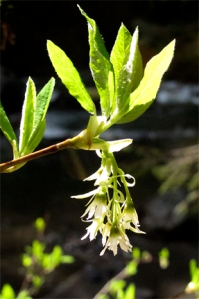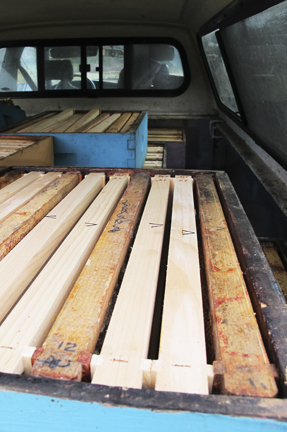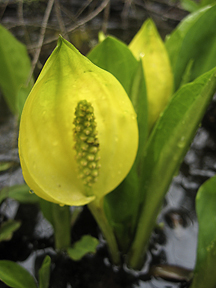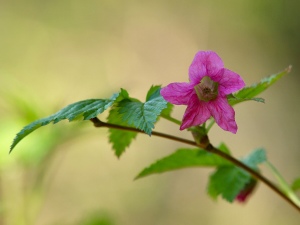Spring arrived early here this year. So I’ve supered the strong hives, many of which were packed with brood, and fed honey to those that had eaten nearly all their stores.
Bees On Brood
This is a spring that follows a very odd winter, which, after a freezing December, was warm and wet. The ski areas in this area (a huge economic portion of our economy) barely opened, and many have shut early both here and in Canada. Bees were out and about in January and February – probably remarking, in a complicated dance-step, about the absolute lack of flowering plants.
What’s Out There For Honeybees?
The first pollen plants, Hazelnuts and Alder, do come out around the turning of the year. However, hazelnuts are scarce in my area. Alder is plentiful, but bees need a lot of for any nutritional benefit.
The first nectar flows are Oso Berry Flowers in February, which I think are worked more by native bumblebees than honeybees.
Oso Berry Flower
They are followed by Big Leaf Maples, usually in early April.
Big Leaf Maple Bloom courtesy of Encyclopedia of Life
This year the Big Leaf Maples started about 4 weeks ago down river, and popped about 2 weeks ago upriver. This, by my notes, is about 3 weeks earlier than in previous years.
There are a lot of Big Leaf Maples upriver, and they deliver a lot of honey. So supers need to be on before they bloom.
Setting Up Supers
I rotate out older comb. The goal is to move anything out over 5 years old. The dates start from the year the comb is fully drawn out.
Supers are put together before I head out on the road to visit the bee yards.
The frame pattern is pretty standard, for me:
Frames 1 and 10 are older drawn comb: somewhere in the 3 to 5 year old range or less. Frames 2,3, 8 and 9 are foundation. Frames 4 and 7 are drawn, 3-years-old or less. Frames 5 and 6 Foundation. Confused? Here’s the scheme:
O/D = Older-Drawn Foundation
F = Foundation
N/D = Newer-Drawn Foundation
O/D F F N/D F F N/D F F O/D
The drawn comb for frame position #4 is not in place yet.
At the Hives
Supers Stacked by Hives
- I set a prepared super on the upturned top next to the hive being worked
- Remove the foundation from positions 5 and 6 (I also take out one of the N/D frames to make some space to work).
- From the hive I pull up the two center frames of brood
- These are put in the center of the super – making sure the side that faces front still faces front.
- I then put the N/D (newer drawn) frame back in the super.
- In the top box of the hive (not the super), I leave frames 1 and 10 in place, but push the others towards the center
- This leaves spaces 2 and 9 open in the hive.
- The two foundations that traveled with the super, but were removed in the first step, are placed in spots 2 and 9.
- The super is then put on top of the hive.
- The hive is closed up.
Works Every Time
No it doesn’t. Sometimes there’s too much honey left in a hive and I pull some of that up as well. Then I use the other frames to make up the difference in the lower boxes. But at least I’ve got a starting set-up that works in about 80% of the cases.
I also carry a box of foundation, a box of drawn comb, and, in the spring, usually 2 boxes of honey along with the prepared supers.
Supers to Go
I hate being 40 minutes away from supplies when a surprise hits me. Beekeeping: expect the unexpected, eh?
The Frame Numbers
The numbers on my frames represent the year that the comb was drawn out. The arrows are because I use the Housel Method of frame placement.
Why the numbers get changed:
I tend to number as I wire and hang wax, so sometimes, I have to write new numbers as the frames don’t make it in the hive on their first year. Sometimes the frames don’t get drawn out until the next year, or the next year – it just depends on the hives and the honey flow and the positions of the frames.
Later In the Year
Later in the year, this won’t work. The brood will be any number of boxes down. Then I usually checkerboard honey and drawn frames, or draw up honey to surround sections of foundations which are lined up together. When that happens, I’ll take pictures
What’s Happening Now:
Spring is well and truly kicking off. The Big Leaf Maples are heavy with bloom and have buds still coming on. are about to set flower. Skunk Cabbage (honeybees like this) and Salmonberry Flowers are in bloom.
Skunk Cabbage
Salmonberry Blossom
As I mentioned, it’s all moving faster than previous years around here.
How do I know? I write down when the flowers bloom on a calendar every year, then keep the calendars in the office so I can go check. I find keeping notes of flowers, the weather, and bee activities, from brood to swarms to supercedures, enables me to have a notion of when and possible ideas for why things are changing in the hives and what I can do to best work with the bees – it’s a symbiotic relationship, I need to hold up my end.









